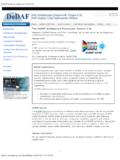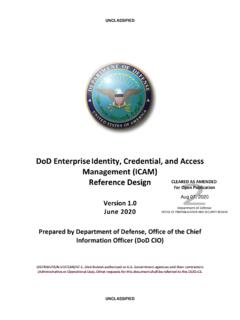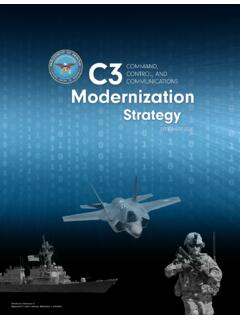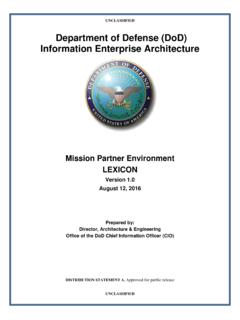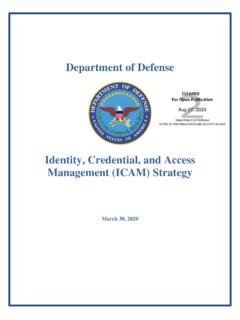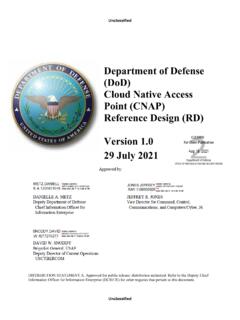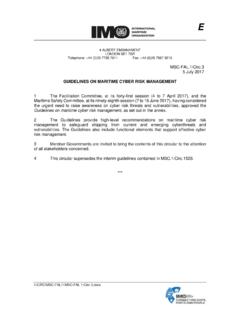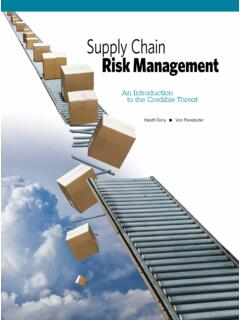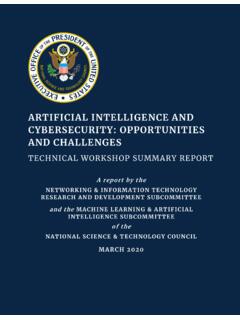Transcription of The purpose of this document is to provide an overview of ...
1 The purpose of this document is to provide an overview of useful, readily available references to support Security Cooperation across the government, commercial sector, and allies and partners. Within this document , readers will find information regarding cybersecurity norms, best practices, policies, and standards written and adopted by the federal government, the Department of Defense, and recognized institutional standards. Table of Contents purpose .. 3 Disclaimers .. 3 Introduction .. 4 Quick Guide .. 4 Developing a cybersecurity Strategy and Supporting Policies .. 5 United States Resources .. 6 International Resources .. 9 Other Sources .. 12 Building Defensible Networks and Protecting Networks from Incidents .. 12 United States Resources .. 13 International Resources .. 18 Critical Infrastructure Protection .. 19 United States Resources .. 19 International Resources .. 21 Managing Access in Systems and Data.
2 22 United States Resources .. 22 Sharing Information .. 24 United States Resources .. 25 International Resources .. 27 Building and Maintaining a Cyber Workforce .. 28 United States Resources .. 28 Appendix .. 37 Quick Reference Chart .. 37 Acronym List .. 39 Seven Steps to Effectively Defend Industrial Control 41 National Security Agency (NSA) Top 10 Mitigation Strategies .. 48 DoD cybersecurity Policy Chart .. 50 Published February 2019 Page | 3 purpose The purpose of this document is to provide a useful reference of both and International resources, in order to develop cybersecurity programs and to build and maintain strong network protection. Extensive reference materials exist that support efforts to build and operate trusted networks and ensure information systems maintain an appropriate level of confidentiality, integrity, authentication, non-repudiation, and availability. The resources compiled here support security cooperation and shared best practices to help achieve collective cybersecurity goals.
3 This guide provides readily available and unclassified information pertaining to cybersecurity norms, best practices, security cooperation, policies and standards authored and adopted by the United States ( ) government, the Department of Defense (DoD), and recognized international institutes and workforce development training resources provided by government, industry, and academia. Disclaimers This reference and resource guide is a compilation of readily available and unclassified resources and should not be considered an exhaustive list. Abstracts, diagrams, and descriptions were taken directly from the sources websites. DoD Senior Information Security Officer (SISO) does not claim authorship of resource descriptions and gives full credit to the organizations referenced. The guide attempts to link to the most authoritative source for each item represented and will be updated on an annual basis as needed. References to any specific products, processes, or services by trade name, trademark, manufacturer, or otherwise does not necessarily constitute or imply its endorsement, recommendation, or favoring by DoD CIO SISO.
4 For further information or to report a broken or invalid link, please contact the DCIO- cybersecurity International Division at Published February 2019 Page | 4 Introduction In order to maintain strong network defenses and to ensure information remains a shared strategic asset, the DoD CIO promotes cybersecurity collaboration with international partners by sharing information. This includes standards and best practices for building and defending networks, incident recovery, and developing strong cyber workforces. Regardless of architecture, security control automation, workforce development, or other initiatives put in place in an organization, good network security cannot be achieved without good network operations. Developing effective monitoring and analysis capabilities, incident response procedures, efficient communication management and control, and timely reporting are the fundamental characteristics of healthy network operations on which strong network security can be built.
5 The resources compiled here reflect the DoD CIO s commitment to support security cooperation, share best practices, and assist partners in the development of cybersecurity programs and the creation and maintenance of strong network protection. Quick Guide DoD CDoD Directives/Instruction/Manual CNSS (Committee on National Security Systems) CJCSM (Chairman of the Joint Chiefs of Staff Manual) Non-DoD NIST (National Institute of Standards and Technology) FIPS (Federal Information Processing Standards) ISO (International Organization for Standardization) CSIRT (Computer Security Incident Response Team) NCCIC (National cybersecurity and Communications Integration Center) References to help answer cybersecurity -related questions quickly and efficiently: Glossary References CNSS Instruction No. 4009, Committee on National Security Systems Glossary, April 2015 Website: NIST Interagency Report (IR) 7298, Revision 3, Glossary of Key Information Security Terms, July 2019 Website: Federal Information Processing Standards (FIPS) Under the Information Technology Management Reform Act (Public Law 104-106), the Secretary of Commerce approves standards and guidelines that are developed by the NIST for federal computer systems.
6 These standards and guidelines are issued by NIST as FIPS for use government-wide. NIST develops FIPS when there are compelling Federal government requirements, such as for security and interoperability, and there are no acceptable industry standards or solutions. Website: Published February 2019 Page | 5 NIST Special Publications (SP) 800 Series The Special Publications (SP) 800 series presents documents of general interest to the computer security community and reports on research, guidelines, and outreach efforts in computer security, and its collaborative activities with industry, government, and academic organizations. Special publications relating to a risk management framework (RMF) or to securing network architecture are included here. The complete text of all Special Publication 800 series documents can be downloaded at: Website: Committee on National Security Systems The CNSS sets national-level cybersecurity policies, directives, instructions, operational procedures, guidance, and advisories for Government departments and agencies for the security of national security systems.
7 It provides a comprehensive forum for strategic planning and operational decision-making to protect national security systems and approves the release of information security products and information to foreign governments. Website: DoD cybersecurity Policy Chart, May 22, 2019 The goal of the DoD cybersecurity Policy Chart is to capture the tremendous breadth of applicable policies, some of which many cybersecurity professionals may not even be aware of, in a helpful organizational scheme. The use of color, fonts, and hyperlinks are all designed to provide additional assistance to cybersecurity professionals navigating their way through policy issues in order to defend their networks, systems, and data. Please see the graphic in the Appendix. Website: Developing a cybersecurity Strategy and Supporting Policies The purpose of a strategy is to guide an organization or a country in achieving a series of objectives over time; often, a strategy sets a course for a four- or five-year period.
8 This period of time is required to enact change, achieve end-states, and to allocate financial means to build and sustain organizational missions. To succeed, a strategy must assess strategic interests, as well as the geopolitical environment for operations. It must set strategic end-states to achieve; it must identify the missions required to achieve those end-states; and it must identify the policy, personnel, and financial investments necessary to execute required missions and achieve required end-states. It is imperative that defense organizations develop the appropriate strategies for protecting interests in cyberspace, develop policies to further clarify how those strategies will be implemented, and develop the appropriate organizational structure to coordinate efforts within individual services and across services. Defense organizations must develop a cyber protection strategy, tied into a national-level effort, so that investments made to develop cyber capabilities are in support of overarching national strategic objectives.
9 Policies, instruction, and directives are used to guide the decisions determined in the strategy and to achieve desired outcomes. Several resources pertaining to strategic vision and examples of national and ministerial level strategies, supporting policies, and directives are included below. Published February 2019 Page | 6 United States Resources National Security Strategy (NSS), 2017 The publication of the National Security Strategy (NSS) is a milestone for any presidency. A statutorily mandated document , the NSS explains to the American people, allies and partners, and federal agencies how the President intends to put his national security vision into practice on behalf of fellow citizens. Website: National Defense Strategy (NDS), 2018 The National Defense Strategy (NDS) is used to establish the objectives for the plans for military force structure, force modernization, business processes, supporting infrastructure, and required resources (funding and manpower).
10 The NDS plays a key role in identifying the capabilities required by the warfighters to support the NSS. Website: National Cyber Strategy of the United States of America, 2018 America s prosperity and security depend on how we respond to the opportunities and challenges in cyberspace. Critical infrastructure, national defense, and the daily lives of Americans rely on computer-driven and interconnected information technologies. As all facets of American life have become more dependent on a secure cyberspace, new vulnerabilities have been revealed, and new threats continue to emerge. Building on the NSS and the Administration s progress over its first 18 months, the National Cyber Strategy outlines how the will ensure the American people continue to reap the benefits of a secure cyberspace that reflects our principles, protects our security, and promotes our prosperity. Website: Department of Defense Cyber Strategy, 2018 The 2018 DoD Cyber Strategy represents the Department s vision for addressing this threat and implementing the priorities of the NSS and NDS for cyberspace.

